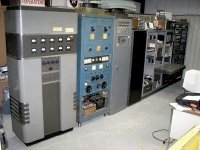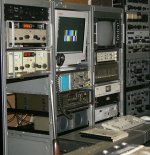You would really still need a pre amp since the the output of almost any mic is well below line level. You might be able to crank up the gain somewhere along the line but it will be noisy.
Once you get a microphone, USB or otherwise, take note that all directional mic's exhibit to some degree something called the proximity effect. http://en.wikipedia.org/wiki/Proximity_effect_(audio)
This has the result that the closer you get to the mic the fuller/more bass heavy your voice will be. This can be used as a very effective acoustical eq but you will have to maintain a quite precise distance to the mic as small variations can have a large effect.
Easiest way to achieve that is with a pop shield (Pop filter - Wikipedia, the free encyclopedia). You can make a perfectly usable one from a wire coathanger and some tights or a stocking.
PS: In my opinion an interface like the Tascam is really very useful since it takes care of everything and the convertors are better than anything in an affordable mic or even your computer. It also comes with some useful software (at least in the UK).
Once you get a microphone, USB or otherwise, take note that all directional mic's exhibit to some degree something called the proximity effect. http://en.wikipedia.org/wiki/Proximity_effect_(audio)
This has the result that the closer you get to the mic the fuller/more bass heavy your voice will be. This can be used as a very effective acoustical eq but you will have to maintain a quite precise distance to the mic as small variations can have a large effect.
Easiest way to achieve that is with a pop shield (Pop filter - Wikipedia, the free encyclopedia). You can make a perfectly usable one from a wire coathanger and some tights or a stocking.
PS: In my opinion an interface like the Tascam is really very useful since it takes care of everything and the convertors are better than anything in an affordable mic or even your computer. It also comes with some useful software (at least in the UK).
Last edited:
What exactly will you be using the mic for? I was unsure if you were using the mic for ham radio or if you were using a ham radio mic for something else.
Getting a hifi full range mic is pretty pointless for communications uses. Try running a 100Hz signal into a telephone and nothing will come out at the other end of the line.
If you are making recordings, that is a different matter. And it matters if you are recording human voice speaking or singing, or if you are micing say a guitar amp speaker or an organ Leslie.
Phantom power is alive and well, a good quality mixer would be naked without phantom.
When you say directional, assuming you want the mic to reject sound from the rear and off-axis, look for a "cardioid" pickup pattern.
Ok, well think I derailed the Icypro's thread a little, didn't mean to, it seems he is doing hi-fi stuff. So I'll just explain why i need a good mike and that should be it.
To make a reasonable communications bandwidth without amplitude or frequency distortion becoming a big issue, say to do 200hz to 3000Hz, it is necessary to have an audio chain that will do at least 50Hz to 10KHz.
Almost all my ham radio activity is AM and use tube stuff. This includes building some of it because even on the used market it's high. I build tube stuff but never any mike preamp except a 1/4" jack thing that was also for guitar for a friend. The pic. shows I still have some building to do in the low level audio department.
Directional to mostly pick up my voice, not so much noise from the blowers in the transmitting equipment and racks, etc. I want the mike on a boom facing me, and to speak at it from an average distance. I'll use a compressor to level the output.
Bad audio sounds real bad on AM. In this situation, I do not want the cheap mike to be the limiting factor of the communications-quality passband. Good audio, flat and undistorted, from 200-3000Hz, is very important to me and the first thing in the chain is the microphone.
The results others have achieved in the AM part of the ham radio hobby show that it is not pointless to use a good quality microphone and to use equipment that is at least as good as "AM radio station" equipment, some of which they build themselves. It's completely reasonable. so anyway that ends my sidetrack of the topic and I'll read those resources.
Attachments
Aha, I did lump your post in with his in my head.
No doubt one wants to use a good quality mic, but that is not the same as broadcast quality. There are cheapo imported phones nowdays that sound bad, but in the day, a regular telephone carbon mic sounded perfectly clear through the bandwidth limited phone system.
For spoken communication flat is not necessary, in fact a presence peak might be desirable.
Any local music store can show you microphones. One that fits in a mic clip for the end of a mic stand is hardly an unusual request. Cardiod pattern mics are common as pigeons in a city park. Get one with a wind ball or put a wind ball over one that has none. In other words a Shure SM58 would be better for you than an SM57. You really do not need a $300 mic. You can build or buy a preamp for your mic if you want a hotter signal into your rig.
No doubt one wants to use a good quality mic, but that is not the same as broadcast quality. There are cheapo imported phones nowdays that sound bad, but in the day, a regular telephone carbon mic sounded perfectly clear through the bandwidth limited phone system.
For spoken communication flat is not necessary, in fact a presence peak might be desirable.
Any local music store can show you microphones. One that fits in a mic clip for the end of a mic stand is hardly an unusual request. Cardiod pattern mics are common as pigeons in a city park. Get one with a wind ball or put a wind ball over one that has none. In other words a Shure SM58 would be better for you than an SM57. You really do not need a $300 mic. You can build or buy a preamp for your mic if you want a hotter signal into your rig.
Well, I'm here again, seeking for your help.
So basically I bough the AT2020 mic and as far as I know, it should have amazing sound. But using my preamp Behringer Mic200 it really doesn't!
So now I'm confused and I don't know what's the core of the problem...
Is it the preamp, tube inside of preamp or cables??
Help me please.
So basically I bough the AT2020 mic and as far as I know, it should have amazing sound. But using my preamp Behringer Mic200 it really doesn't!
So now I'm confused and I don't know what's the core of the problem...
Is it the preamp, tube inside of preamp or cables??
Help me please.
- Status
- This old topic is closed. If you want to reopen this topic, contact a moderator using the "Report Post" button.

